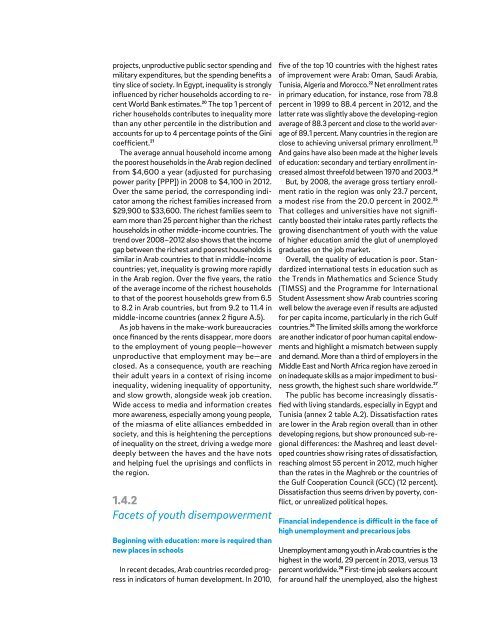Arab Human Development Report 2016
z6bSXU
z6bSXU
You also want an ePaper? Increase the reach of your titles
YUMPU automatically turns print PDFs into web optimized ePapers that Google loves.
projects, unproductive public sector spending and<br />
military expenditures, but the spending benefits a<br />
tiny slice of society. In Egypt, inequality is strongly<br />
influenced by richer households according to recent<br />
World Bank estimates. 20 The top 1 percent of<br />
richer households contributes to inequality more<br />
than any other percentile in the distribution and<br />
accounts for up to 4 percentage points of the Gini<br />
coefficient. 21<br />
The average annual household income among<br />
the poorest households in the <strong>Arab</strong> region declined<br />
from $4,600 a year (adjusted for purchasing<br />
power parity [PPP]) in 2008 to $4,100 in 2012.<br />
Over the same period, the corresponding indicator<br />
among the richest families increased from<br />
$29,900 to $33,600. The richest families seem to<br />
earn more than 25 percent higher than the richest<br />
households in other middle-income countries. The<br />
trend over 2008–2012 also shows that the income<br />
gap between the richest and poorest households is<br />
similar in <strong>Arab</strong> countries to that in middle-income<br />
countries; yet, inequality is growing more rapidly<br />
in the <strong>Arab</strong> region. Over the five years, the ratio<br />
of the average income of the richest households<br />
to that of the poorest households grew from 6.5<br />
to 8.2 in <strong>Arab</strong> countries, but from 9.2 to 11.4 in<br />
middle-income countries (annex 2 figure A.5).<br />
As job havens in the make-work bureaucracies<br />
once financed by the rents disappear, more doors<br />
to the employment of young people—however<br />
unproductive that employment may be—are<br />
closed. As a consequence, youth are reaching<br />
their adult years in a context of rising income<br />
inequality, widening inequality of opportunity,<br />
and slow growth, alongside weak job creation.<br />
Wide access to media and information creates<br />
more awareness, especially among young people,<br />
of the miasma of elite alliances embedded in<br />
society, and this is heightening the perceptions<br />
of inequality on the street, driving a wedge more<br />
deeply between the haves and the have nots<br />
and helping fuel the uprisings and conflicts in<br />
the region.<br />
1.4.2<br />
Facets of youth disempowerment<br />
Beginning with education: more is required than<br />
new places in schools<br />
In recent decades, <strong>Arab</strong> countries recorded progress<br />
in indicators of human development. In 2010,<br />
five of the top 10 countries with the highest rates<br />
of improvement were <strong>Arab</strong>: Oman, Saudi <strong>Arab</strong>ia,<br />
Tunisia, Algeria and Morocco. 22 Net enrollment rates<br />
in primary education, for instance, rose from 78.8<br />
percent in 1999 to 88.4 percent in 2012, and the<br />
latter rate was slightly above the developing-region<br />
average of 88.3 percent and close to the world average<br />
of 89.1 percent. Many countries in the region are<br />
close to achieving universal primary enrollment. 23<br />
And gains have also been made at the higher levels<br />
of education: secondary and tertiary enrollment increased<br />
almost threefold between 1970 and 2003. 24<br />
But, by 2008, the average gross tertiary enrollment<br />
ratio in the region was only 23.7 percent,<br />
a modest rise from the 20.0 percent in 2002. 25<br />
That colleges and universities have not significantly<br />
boosted their intake rates partly reflects the<br />
growing disenchantment of youth with the value<br />
of higher education amid the glut of unemployed<br />
graduates on the job market.<br />
Overall, the quality of education is poor. Standardized<br />
international tests in education such as<br />
the Trends in Mathematics and Science Study<br />
(TIMSS) and the Programme for International<br />
Student Assessment show <strong>Arab</strong> countries scoring<br />
well below the average even if results are adjusted<br />
for per capita income, particularly in the rich Gulf<br />
countries. 26 The limited skills among the workforce<br />
are another indicator of poor human capital endowments<br />
and highlight a mismatch between supply<br />
and demand. More than a third of employers in the<br />
Middle East and North Africa region have zeroed in<br />
on inadequate skills as a major impediment to business<br />
growth, the highest such share worldwide. 27<br />
The public has become increasingly dissatisfied<br />
with living standards, especially in Egypt and<br />
Tunisia (annex 2 table A.2). Dissatisfaction rates<br />
are lower in the <strong>Arab</strong> region overall than in other<br />
developing regions, but show pronounced sub-regional<br />
differences: the Mashreq and least developed<br />
countries show rising rates of dissatisfaction,<br />
reaching almost 55 percent in 2012, much higher<br />
than the rates in the Maghreb or the countries of<br />
the Gulf Cooperation Council (GCC) (12 percent).<br />
Dissatisfaction thus seems driven by poverty, conflict,<br />
or unrealized political hopes.<br />
Financial independence is difficult in the face of<br />
high unemployment and precarious jobs<br />
Unemployment among youth in <strong>Arab</strong> countries is the<br />
highest in the world, 29 percent in 2013, versus 13<br />
percent worldwide. 28 First-time job seekers account<br />
for around half the unemployed, also the highest


